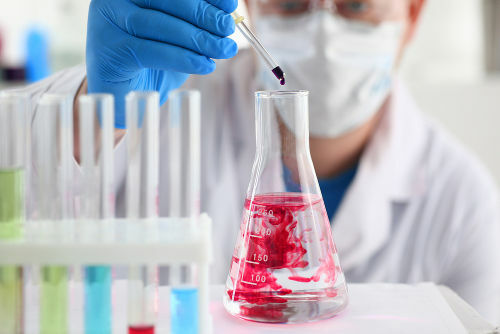The solubility product (Kps) is an equilibrium constant related to the solubility of the solute.
This situation occurs with poorly water-soluble salts, in which the product of the molar concentration of ions is a constant, which we call the product of solubility.
Its calculation is related to the dissolution equilibrium and the concentration of ions in the solution. This is because if a solid is ionic, ionic dissolution in water will take place.
Look at the example of silver chloride:
AgCl(s) ⇔ Ag+ (aq) + Cl- (here)
Solid silver chloride has very low solubility in water. When placed in an aqueous solution, Ag is formed+ (aq) and Cl-(aq).
After a time in solution, the solid silver chloride dissociates with the same rate of formation as Ag ions+ and Cl-. At that moment, the balance was reached, which can be calculated.
How to calculate Kps?
We can express the Kps calculation as follows:
ApBq ⇔ pAq+. qBP-
Kps = [Aq+]P. [BP-]what
See the example with lead bromide II:
PbBr2 ⇔ Pb+2 (aq) + 2 Br-1 (here)
Kps = [Pb2+]. [Br-1]2
Read too:
- chemical solutions
- Concentration of solutions
- Solubility
- solubility coefficient
Solved Exercises
1. At 36.5 °C the solubility of barium sulfate in water (BaSO4(aq)) is equal to 1.80.10-5 mol/L. Calculate the product of the solubility of this salt at 36.5 °C.
Resolution:
BASO4(s) Ba2+ (aq) + SO4-2 (here)
Kps = [Ba2+]. [ONLY4-2]
Kps = (1.80.10-5 mol/L). (1,80.10-5 mol/L)
Kps = 3.24.10-10
2. (FUVEST) At a given temperature, the solubility of silver sulfate in water is 2.0.10-2 mol/L. What is the value of the solubility product (Kps) of this salt at the same temperature?
Resolution:
Ag2ONLY4 ⇔ 2 Ag+ + 1 ONLY4-2
Kps = [Ag+]2. [ONLY4-2]
To find out the solubility of each ion, let's make the following proportions:
1 Ag2ONLY4 = 2,0.10-2 mol/L, then: 2 Ag+ = 4,0.10-2 mol/L and 1 ONLY4-2 = 2,0.10-2 mol/L
Now just replace the values in the equation:
Kps = [4 x 10-2]2 . [2 x 10-2]
Kps = 16 x 10-4 . 2 x 10-2
Kps = 32 x 10-6
Kps = 3.2 x 10-5
Solubility Product Table
The value of Kps varies with temperature, substances have constant Kps at a certain temperature. Check out some examples of Kps at 25 °C:
| Substances | Formulas | Kps |
|---|---|---|
| lead sulphide | PbS | 3,4.10-28 |
| silver sulphide | Ag2s | 6,0.10-51 |
| aluminum hydroxide | Al(OH)3 | 1,8.10-33 |
| Iron(III) hydroxide | Fe(OH)3 | 1,1.10-36 |
| nickel sulphide | NiS | 1,4.10-24 |
| Barium sulphate | BASO4 | 1,1.10-10 |
Exercises
1. (UFPI) The solubility of calcium fluoride at 18 °C is 2.10-5 mol/liter. The solubility product of this substance at the same temperature is:
a) 8.0 × 10-15
b) 3.2 × 10-14
c) 4 × 10-14
d) 2 × 10-5
e) 4 × 10-5
Alternative b) 3.2 × 10-14
2. (Mackenzie-SP) The solubility product of calcium carbonate (CaCO3), which has a solubility of 0.013 g/L at 20°C, is:
a) 1.69 × 10-4
b) 1.69 × 10-8
c) 1.30 × 10-2
d) 1.30 × 10-8
e) 1.69 × 10-2
Alternative b) 1.69 × 10-8
3. (PUC-Campinas) The solubility product of ferric hydroxide, Fe(OH)3, is expressed by the relationship:
a) [Fe3+] · 3 [OH– ]
b) [Fe3+] + [OH–]3
c) [Fe3+] · [OH–]3
d) [Fe3+] / [OH-]3
e) [Fe-]3 / [OH3+]
Alternative c) [Fe3+] · [OH–]3



